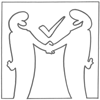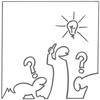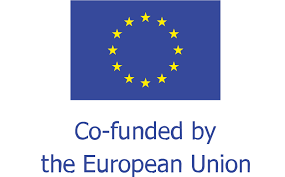Learning Objective(s)
- Boost communication skills and show the importance and practicality of open ended questions. Rather than yes or no (closed) questions.
- Increase confidence in communicating
- Build relationships and openness.
Instructions
- To start, separate the group into two teams of equal (or roughly equal) size.
- Instruct one player from each team to leave the room for one minute and come up with a common object that can be found in most offices (e.g., a stapler, a printer, a whiteboard).
- When this person returns, their teammates will try to guess what the object is by asking only “Yes or No” questions (i.e., questions that can only be answered with “yes” or “no”). The team can ask as many questions as they need to figure it out, but remind them that they’re in competition with the other team. If there’s time, you can have multiple rounds for added competition between the teams.
- Take the last 10 minutes or so to discuss and debrief. Use the following points and questions to guide it:
- Tell the group that obviously it took a long time and effort for us to find out the object in each round, but what if we didn’t have time and only had one question to ask to find out the object, what would that question be?
- The question would be “What is the object?” which is an open-ended question.
- Open-ended questions are an excellent way to save time and energy and help you get to the information you need fast, however, closed questions can also be very useful in some instances to confirm your understanding or to help you control the conversation with an overly talkative person/customer.
Collecting and sharing student results
Time taken and discussion from learners will be observed along with a work sheet to describe the importance and examples of effective questioning and using open ended questions.
Instructions
- To start, separate the group into two teams of equal (or roughly equal) size.
- Instruct one player from each team to leave the room for one minute and come up with a common object that can be found in most offices (e.g., a stapler, a printer, a whiteboard).
- When this person returns, their teammates will try to guess what the object is by asking only “Yes or No” questions (i.e., questions that can only be answered with “yes” or “no”). The team can ask as many questions as they need to figure it out, but remind them that they’re in competition with the other team. If there’s time, you can have multiple rounds for added competition between the teams.
- Take the last 10 minutes or so to discuss and debrief. Use the following points and questions to guide it:
- Tell the group that obviously it took a long time and effort for us to find out the object in each round, but what if we didn’t have time and only had one question to ask to find out the object, what would that question be?
- The question would be “What is the object?” which is an open-ended question.
- Open-ended questions are an excellent way to save time and energy and help you get to the information you need fast, however, closed questions can also be very useful in some instances to confirm your understanding or to help you control the conversation with an overly talkative person/customer.
Collecting and sharing student results
Time taken and discussion from learners will be observed along with a work sheet to describe the importance and examples of effective questioning and using open ended questions.
Assessment Methods
- Observation
- Discussion
- Worksheet
Resources needed
- Notebooks


 30-60 Minutes
30-60 Minutes











